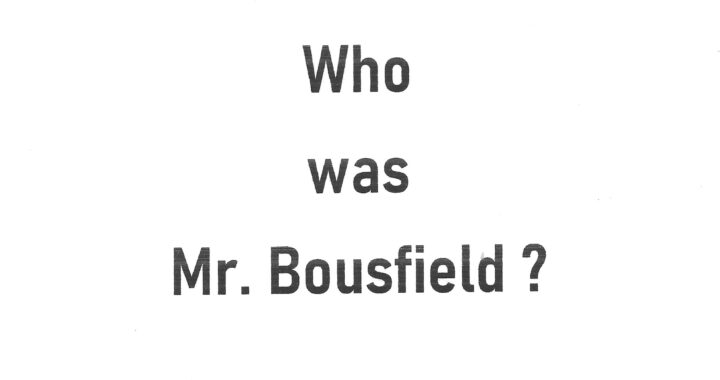Little has been written about Mr Bousfield, who went into partnership with James and Charles Finlayson to form Finlayson, Bousfield & Co, in Johnstone in 1848. The only indication of his origin is found in an article by the Paisley Correspondent of the Glasgow Citizen describing the Johnstone Grand Industrial Exhibition, held in the town in 1853. Mr Bousfield had contributed specimens of silk tabaretts, and silk damask and tissues, for display at the exhibition and these had been manufactured chiefly at Spitalfields. This information indicated a possible clue to his past and merited further investigation.
Recent research has revealed that Charles Holehouse Bousfield was born in London on 9th of February, 1822, and baptised in St. Olave, Old Jewry, London. His mother was Sarah Holehouse and his father, Charles Pritchett Bousfield, was a silk manufacturer in London. As children, Charles and his siblings are likely to have lived in a very busy household, which may have included on the premises his father’s indentured weaver apprentices.
In 1836, at the age of fourteen, Charles was indentured as an apprentice to his father to learn the Art of a Silk Manufacturer. In 1843, on completion of his apprenticeship, young Charles was admitted as Freeman of the City of London. In the late 1840s, when he came to Scotland, possibly on business for his father who was a partner in Lea, Bousfield & Co., silk manufacturers in Cheapside, London, he appears to have been well-respected in Glasgow business circles. Presumably, with an eye to the main chance, he saw in James Finlayson the potential of future success and went into partnership with him to form Finlayson, Bousfield & Co. In 1851, and possibly earlier, he is known to have lodged with William and Helen Finlayson, the Finlayson brothers’ parents, beside the mill at Johnstone Bridge in the High Street. He is listed as a proprietor of Finlayson Bousfield in Johnstone in 1855 and1865. But, unlike the Finlayson brothers, little of his personal life or social involvement in Johnstone is recorded.
In addition to his contribution of silk goods on display at the Johnstone Grand Industrial Exhibition (1853), he is known to have hosted a meeting in the Public Hall in Johnstone in November, 1873, when Sheriff Clerk of Glasgow gave a history lecture to the Johnstone Working Men’s Institute. One perhaps more significant mention of him is contained in the text of Charles Finlayson’s address to the guests at the opening of Finlayson Bousfield’s Lilybank Bowling Green in 1874. In the address it is mentioned that Mr Bousfield, although a partner in the firm, was not well known to the Flax Mill employees. This may be explained by the fact that by the late 1860s he was living in Glasgow.
Despite the success of the company, Charles Holehouse Bousfield ended his partnership in Finlayson, Bousfield & Co. on 13th November, 1876. It is documented that he would have no further interest in the business which would be carried on under James Finlayson, Thomas Coats, and James’s three sons, William James Finlayson, Archibald Watson Finlayson and James Finlayson, Jun.
Charles Holehouse Bousfield appears to have had returned permanently to London where his main residence was 40 Elvaston Place, Queensgate, Kensington. In London he was a member of the prestigious gentlemen’s club, the National Club, London, and had involvement in charities and mission work. He died at 29 Ashburn Place, on 12th March, 1906, and was buried in Norwood Cemetery, Lambeth, leaving a considerable fortune of £497,962. 17s. 2d. to his sister, Cornelia, the widow of Hugh Huleatt, and £45,885.12s. to her daughter, Frances Emma Huleatt, widow of Archibald Mungo Muir. But how he accumulated this substantial estate is a mystery.
© 2023 Helen Calcluth,

